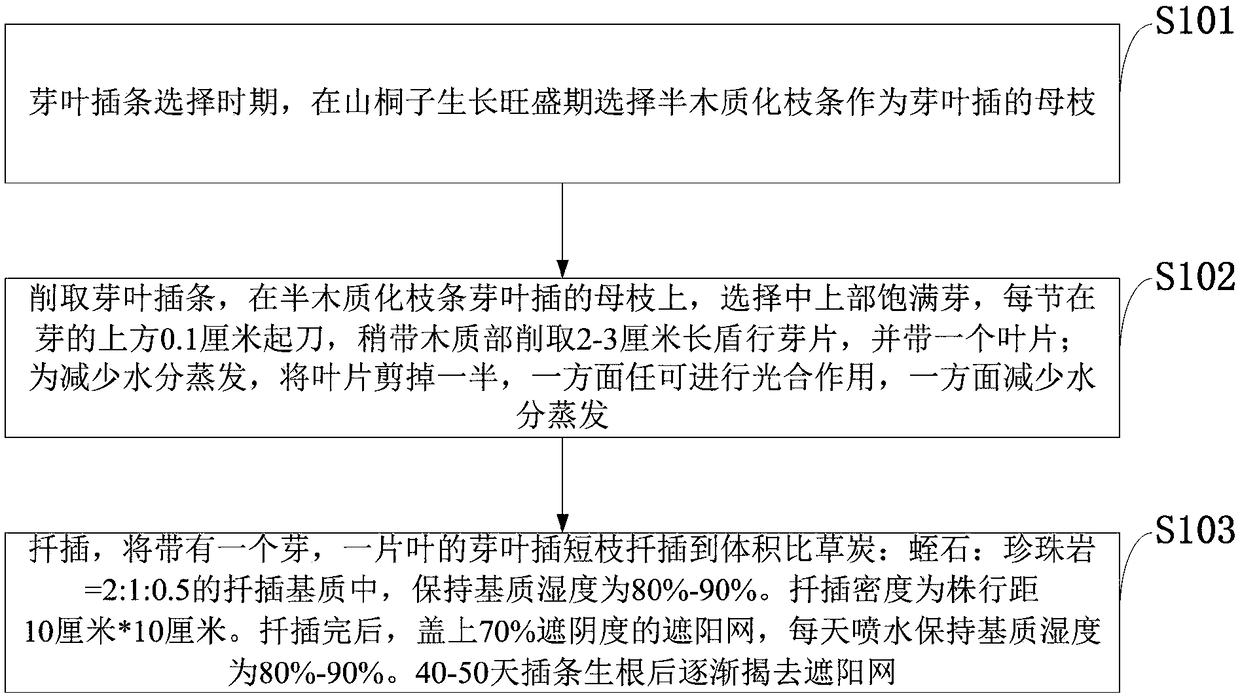Method for improving cutting survival rate of Idesia polycarpa
A technology of survival rate and S. japonica is applied in the fields of botanical equipment and methods, horticulture, vegetative reproduction, etc., and can solve the problems of cuttings dying of young branches and hard branches, low survival rate of cutting methods, and large demand for cuttings, etc. Improve the survival rate of cuttings, improve the survival rate of cuttings, and ensure the effect of good maintenance
- Summary
- Abstract
- Description
- Claims
- Application Information
AI Technical Summary
Problems solved by technology
Method used
Image
Examples
Embodiment 1
[0029] In 2014, a trial of cuttings of Jatropha japonica buds and leaves was carried out in Hehua Village, Shaxi Township, Lichuan City, Hubei Province.
[0030] 1. Leaf cuttings selection period
[0031] On June 28, 2014, semi-lignified branches were selected as the mother branches for bud leaf cuttings during the vigorous growth period of Jatropha.
[0032] 2. Peel off bud leaf cuttings
[0033] In time, on the mother branch of semi-lignified branches with buds and leaves inserted, select the full buds in the middle and upper parts, cut each node 0.1 cm above the buds, cut off the 2-3 cm long shield-row buds with a little xylem, and bring a leaf . In order to reduce water evaporation, half of the leaves are cut off. On the one hand, photosynthesis can be carried out, and on the other hand, water evaporation can be reduced.
[0034] 3. Cuttings
[0035] On June 28, 2014, cuttages with one bud and one leaf were inserted into the cutting substrate with a volume ratio of pea...
Embodiment 2
[0037] In 2015, a trial of Jatropha bud leaf cuttings was carried out in Aishan Village, Xuan'en County, Hubei Province.
[0038] 1. Leaf cuttings selection period
[0039] On July 2, 2015, semi-lignified branches were selected as the mother branches for bud leaf cuttings during the vigorous growth period of Jatropha.
[0040] 2. Peel off bud leaf cuttings
[0041] In time, on the mother branch of semi-lignified branches with buds and leaves inserted, select the full buds in the middle and upper parts, cut each node 0.1 cm above the buds, cut off the 2-3 cm long shield-row buds with a little xylem, and bring a leaf . In order to reduce water evaporation, half of the leaves are cut off. On the one hand, photosynthesis can be carried out, and on the other hand, water evaporation can be reduced.
[0042] 3. Cuttings
[0043] On July 2, 2015, cuttages with one bud and one leaf were inserted into the cutting substrate with a volume ratio of peat: vermiculite: perlite = 2:1:0.5,...
Embodiment 3
[0045] In 2016, a trial of cuttings of Jatropha japonica buds and leaves was carried out in Guankou Village, Jianshi County, Hubei Province.
[0046] 1. Leaf cuttings selection period
[0047] On July 5, 2016, semi-lignified branches were selected as the mother branches for bud leaf cuttings during the vigorous growth period of Jatropha.
[0048] 2. Peel off bud leaf cuttings
[0049] In time, on the mother branch of semi-lignified branches with buds and leaves inserted, select the full buds in the middle and upper parts, cut each node 0.1 cm above the buds, cut off the 2-3 cm long shield-row buds with a little xylem, and bring a leaf . In order to reduce water evaporation, half of the leaves are cut off. On the one hand, photosynthesis can be carried out, and on the other hand, water evaporation can be reduced.
[0050] 3. Cuttings
[0051] On July 5, 2016, cuttages with one bud and one leaf were inserted into the cutting substrate with a volume ratio of peat: vermiculite...
PUM
 Login to View More
Login to View More Abstract
Description
Claims
Application Information
 Login to View More
Login to View More - R&D
- Intellectual Property
- Life Sciences
- Materials
- Tech Scout
- Unparalleled Data Quality
- Higher Quality Content
- 60% Fewer Hallucinations
Browse by: Latest US Patents, China's latest patents, Technical Efficacy Thesaurus, Application Domain, Technology Topic, Popular Technical Reports.
© 2025 PatSnap. All rights reserved.Legal|Privacy policy|Modern Slavery Act Transparency Statement|Sitemap|About US| Contact US: help@patsnap.com

